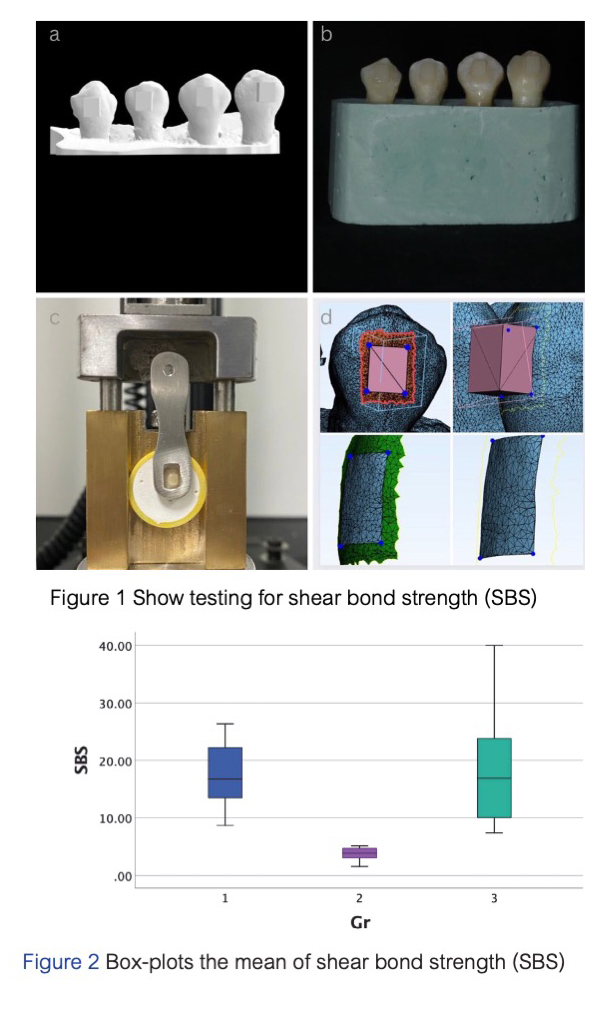Evaluation of bond strength and failure mode of attachments in clear aligner orthodontic appliance using self-adhesive composite resin
Main Article Content
Abstract
Objectives: The study was designed to 1) compare the shear bond strength (SBS) between self-adhesive composite resin and etch and rinse adhesive systems with a conventional flowable composite resin in fabricating the attachment of clear aligner on enamel surface and 2) to evaluate the mode of failure.
Materials and Methods: The rectangular attachment size of 2.5x3x2 mm was fabricated on 48 upper first premolars. These premolars were randomly allocated into three groups based on the attachment bonding protocols: Group 1 (etch and rinse + conventional flowable composite resin), Group 2 (self-adhesive composite resin) and Group 3 (etching + self-adhesive composite resin). The samples were subjected to thermocycling (1,000 cycles between 5°C and 55°C). The SBS was measured by universal testing machine. The data were analyzed using one-way analysis of variance (ANOVA) with a significance level of p < 0.05. All samples were examined under a stereomicroscope at 20x magnification to evaluate the Adhesive Remnant Index (ARI) scores. The scores were presented in percentages.
Results: 62.5% of the attachments in Group 2 became dislodged after thermocycling. The mean SBS of Group 1 (17.3±5.76 MPa) and Group 3 (18.91 ± 9.94 MPa) were statistically significantly higher than that of Group 2 (3.69 ± 1.30 MPa) (p < 0.05). No statistically significant differences were observed between Group 1 and Group 3 (p > 0.05). For ARI evaluation, the majority of samples in Group 1 showed mixed failure, Group 2 show Interfacial failure between composite resin and enamel and Group 3 show cohesive failure in composite resin.
Conclusion: The attachment that were fabricated with self-adhesive composite resin had the lowest SBS in this study. However, etching prior to using self-adhesive composite resin enhanced SBS comparable to etch and rinse + conventional flowable composite resin in fabricating the attachment.
Article Details

This work is licensed under a Creative Commons Attribution-NonCommercial-NoDerivatives 4.0 International License.
References
Tai S. Clear aligner technique. Hanover Park, IL: Quintessence Publishing; 2018.
Proffit WR, Fields HW, Larson B, Sarver DM. Contemporary orthodontics. 6th ed. Philadelphia, PA: Elsevier Health Sciences; 2019.
Al Noor HSS, Al-Joubori SK. Retention of different orthodontic aligners according to their thickness and the presence of attachments. Int J Med Res Health Sci. 2018 Jan;7(11):115-21.
Dasy H, Dasy A, Asatrian G, Rózsa N, Lee HF, Kwak JH. Effects of variable attachment shapes and aligner material on aligner retention. Angle Orthod. 2015 Nov;85(6):934-940. doi: 10.2319/091014-637.1.
Reynolds IR. A review of direct orthodontic bonding. Br J Orthod. 1975 Jul;2(3):171-178. doi: 10.1080/0301228X.1975.11743666.
Bayram M, Yesilyurt C, Kusgöz A, Ulker M, Nur M. Shear bond strength of orthodontic brackets to aged resin composite surfaces: effect of surface conditioning. Eur J Orthod. 2011 Apr;33(2):174-179. doi: 10.1093/ejo/cjq048.
Hilton TJ, Ferracane JL, Broome JC. Summitt's fundamentals of operative dentistry: A contemporary approach. 4th ed. Hanover Park, IL: Quintessence Publishing; 2013.
Vicente A, Bravo LA, Romero M. Influence of a nonrinse conditioner on the bond strength of brackets bonded with a resin adhesive system. Angle Orthod. 2005 May;75(3):400-405. doi: 10.1043/0003-3219(2005)75[400:IOANCO]2.0.CO;2.
Sofan E, Sofan A, Palaia G, Tenore G, Romeo U, Migliau G. Classification review of dental adhesive systems: from the IV generation to the universal type. Ann Stomatol (Roma). 2017 Jul;8(1):1-17. doi: 10. 11138/ads/2017.8.1.001.
kerrdental.com [Internet]. CA; 2016 [cited 2022 Apr 22]. Available from: https://www. kerrdental. com /kerr-restoratives/vertise-flow-self-adhering-flowable- composite.
Valizadeh S, Alimohammadi G, Nik TH, Etemadi A, Tanbakuchi B. Invitro evaluation of shear bond strength of orthodontic metal brackets to aged composite using a self- adhesive composite: Effect of surface conditioning and different bonding agents. Int Orthod. 2020 Sep;18(3):528-537. 10.1016/j. ortho. 2020.04.005.
Pipatphatsakorn M. Microtensile Bond strength of new self-adhesive flowable resin composite on different enamel substrates. CU Dent J. 2015;38:83-96.
Chen W, Qian L, Qian Y, Zhang Z, Wen X. Comparative study of three composite materials in bonding attachments for clear aligners. Orthod Craniofac Res. 2021 Nov;24(4):520-527. doi: 10.1111/ocr.12465.
Van Meerbeek B, De Munck J, Yoshida Y, Inoue S, Vargas M, Vijay P, et al. Buonocore memorial lecture. Adhesion to enamel and dentin: current status and future challenges. Oper Dent. 2003 May-Jun;28(3):215-235.
Vichi A, Margvelashvili M, Goracci C, Papacchini F, Ferrari M. Bonding and sealing ability of a new self-adhering flowable composite resin in class I restorations. Clin Oral Investig. 2013 Jul;17(6):1497-1506. doi: 10.1007/s00784-012-0846-6.
Chantchaimongkol S, Srisawasdi S. Microtensile bond strength of self-adhesive resin composite to dentin. CU Dent J. 2015;38:21-34.
Talan J, Gupta S, Nikhil V, Jaiswal S. Effect of mechanical alteration of enamel surface on shear bond strength of different bonding techniques. J Conserv Dent. 2020 Mar-Apr;23(2):141-144. doi: 10.4103/JCD. JCD_163_19.
Scougall Vilchis RJ, Yamamoto S, Kitai N, Yamamoto K. Shear bond strength of orthodontic brackets bonded with different self-etching adhesives. Am J Orthod Dentofacial Orthop. 2009 Sep;136(3):425-30. doi: 10.1016/j.ajodo.2007.08.024.
Al Shamsi A, Cunningham JL, Lamey PJ, Lynch E. Shear bond strength and residual adhesive after orthodontic bracket debonding. Angle Orthod. 2006 Jul;76(4):694-699. doi: 10.1043/0003-3219(2006) 076 [0694:SBSARA]2.0.CO;2.
Bishara SE, Ostby AW, Laffoon JF, Warren J. Shear bond strength comparison of two adhesive systems following thermocycling. A new self-etch primer and a resin-modified glass ionomer. Angle Orthod. 2007 Mar;77(2):337-341. doi: 10.2319/0003-3219(2007)077[0337:SBSCOT]2.0.CO;2.


